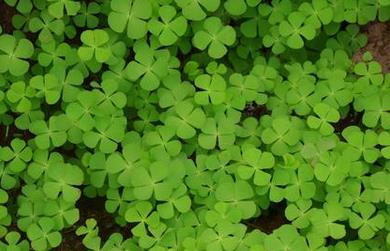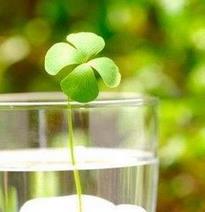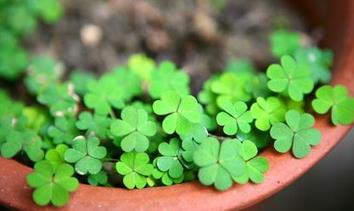[what does four-leaf clover stand for] what does four-leaf clover mean
Four-leaf clover, generally refers to four-leaf sorrel, alfalfa, or clover, it is also known as lucky grass, is a perennial herb. It is said that it would be lucky to find a clover among 100,000 clover plants, so the clover is an internationally recognized symbol of luck. So what does the four-leaf clover mean? What is the meaning of four-leaf clover? Let's get to know it together.

What does four-leaf clover mean?
Legend has it that in 100, 000 alfalfa plants, only one four-leaf clover may be found, because the probability is about 1/100000. Therefore, the four-leaf clover is internationally recognized as a symbol of luck, but in fact this is not the case. Each leaf of the four-leaf clover has a different meaning, fame, wealth, love and health.
In Taiwan, the four-leaf clover generally refers to the four-leaf sorrel. In the Irish folk, the four-leaf clover can bring good luck, is the most famous national symbol of Ireland, and is regarded as the national flower of Ireland. The four-leaf clover is a flower dedicated to St. Patrick, the patron saint of Ireland, who fought a bloody war with Britain for independence. Therefore, its fancy language is patriotic.
In Germany, the four-leaf clover is regarded as a symbol of freedom, unity, unity and peace. People think that something bad can happen with it, so its flower language represents luck and happiness. In Europe, children always find four-leaf clover for fun, which has become the most popular game for children. They generally think that as long as they find four-leaf clover, they can be happy.

The meaning of four-leaf clover
About the legendary four-leaf clover, its four leaves have different meanings, and there are many ways to say it. Let's take a look at the different expressions about the meaning of the four-leaf clover.
The first leaf represents hope, the second leaf represents faith, the third leaf represents love, and the fourth leaf represents luck.
The first leaf represents love, the second leaf represents health, the third leaf represents fame, and the fourth leaf represents wealth.
The first leaf represents true love, the second leaf represents hope, the third leaf represents fame, and the fourth leaf represents happiness.

The symbol of four-leaf clover in different countries
In addition, the meaning of four-leaf clover varies from country to country.
According to Irish folklore, the four-leaf clover can bring good luck and is the most famous national symbol of Ireland. In traditional Irish weddings, the bride's bouquet and the groom's corsage must contain lucky grass. Lucky grass is considered to be the third person indispensable to the wedding.
In Switzerland, real four-leaf lucky grass potted plants can be bought in shopping malls every Christmas. Lucky grass is considered to be the most creative Christmas gift. Lucky grass's good luck is given to relatives, and the recipient will begin to be happy. Everything is going well in this world.
In Germany, the four-leaf clover is regarded as a symbol of freedom, unity, unity and peace.
Perhaps it is precisely because of the special nature of the four-leaf clover that the game of looking for the four-leaf clover is popular in Europe. If you find the four-leaf clover, you can get happiness.

The legend of the four-leaf clover
Legend of the four-leaf clover
The legendary four-leaf clover is said to have been brought to the earth by Eve from the Garden of Eden. Its flower language is happiness, also known as clover. Usually it has only 3 leaves, the probability of finding 4 leaves is very small, the probability of finding 5 leaves is even less, if you want to find 6 leaves, the probability is only 1/100000, which implies happiness and God's blessing.
Legend II of the four-leaf clover
It is said that the name of lucky grass comes from Napoleon. Once he was leading troops across the prairie when he found a four-leaf clover. When he leaned down and picked it, he just dodged the bullet fired at him and escaped. From then on, he called the four-leaf clover lucky. The spread of four-leaf clover has been internationally recognized as a symbol of luck. Its four leaves represent love, health, fame and wealth, respectively. If you have it, you will have good luck.
Three legends of the four-leaf clover
Four-leaf clover first originated in Europe, especially in Britain and Ireland. Today, four-leaf clover has become a folk tradition in western countries. Children always have fun looking for four-leaf clovers on the prairie, and every March on St. Peter's Day in New York, people wear green clothes and bring the so-called mascot, the four-leaf lucky clover ornaments.

Four-leaf clover-cultivation method
Soil and tillage
Four-leaf clover, strong resistance, wide adaptability, lax requirements on the soil, as long as sufficient precipitation, humid climate, good drainage, not strong saline-alkali soil can grow normally; even in the garden can be planted. The seeds are small, the seedlings grow very slowly, and the soil preparation must be fine in order to save the seedlings. No matter sowing in spring or autumn, the soil must be prepared in advance, first shallowly turn over stubble, remove sundries, store water and preserve soil moisture, and then deeply turn and rake the ground every 10 to 15 days, flatten the ground, make the soil pieces fine, and the soil in the sowing layer is loose, so as to be sown.
Fertilizer application
Combined with deep ploughing, applying 1500-2000 kg organic fertilizer per mu, mixed with 15-20 kg superphosphate, accumulating and fermenting for 20-20 days in humid environment, then applying, shallow ploughing soil before sowing, applying 5-8 kg ammonium nitrate per mu to promote seedling growth and give full play to production potential.
Sowing seeds
Seed fields should sow Ⅰ seeds stipulated in national or provincial forage seed quality standards, and artificial grasslands can sow Ⅰ, Ⅱ and Ⅲ seeds. The hard seed rate of white clover seeds is high. Before sowing, the seed coat should be scraped by mechanical method, or soaked in concentrated sulfuric acid to corrode the seed coat. The method of soaking in sulfuric acid is: soak for 20 to 30 minutes, remove and rinse with clean water, then dry and sow seeds. The seed field is sown with 5 kilograms per mu. Sowing 8 kg per mu of artificial grassland should be small in humid areas and large in arid areas. The sowing depth is 1 to 2 meters. Sowing too deep is not easy to emerge, so it should be properly mastered according to the soil texture and dry and wet conditions. Sowing time: spring, summer and autumn, but in higher cold areas, it is better to sow in spring and summer. If sowing in autumn, it should be sowed early, so that the seedlings can grow for more than one month to survive the winter. There are a variety of sowing methods, including single sowing, mixed sowing, strip sowing and sowing.

Field management
Before seedling emergence after sowing, if you encounter soil consolidation, rake in time to break the plate layer to facilitate seedling emergence. The growth is slow in the seedling stage, in order to prevent the harm of weeds, the soil should be ploughed and weeded for 1 or 2 times, and the pests should be controlled in time when they are found. The grassland that has been growing for more than two years has compact soil layer and poor air permeability. before turning green in spring and autumn and before regeneration after grazing and cutting, it is necessary to rake and loosen the soil, combined with loosening soil topdressing, applying 20: 25 kg of calcium superphosphate per mu, or 5 ~ 8 kg of phosphate diamine. to facilitate the growth and development of new shoots and new roots. Four-leaf clover has higher requirements for soil moisture, irrigation conditions, when the soil is dry, or combined with topdressing irrigation. When the growth of mixed grassland is restrained due to the different growth rates of forage grass in the earlier and later stages, such as uncoordinated growth of glory, water and fertilizer, or partial application of nitrogen fertilizer, the growth of grasses should be adjusted by partial application of phosphorus and potassium fertilizer and grazing to control the growth of grasses to avoid inhibition or disappearance from the mixed grassland.
Today, four-leaf clover has become a folk tradition in western countries. Children always have fun looking for four-leaf clovers on the prairie, and every March on St. Peter's Day in New York, people wear green clothes and bring the so-called mascot, the four-leaf lucky clover ornaments.

Four-leaf clover-cultivation method
Soil and tillage
Four-leaf clover, strong resistance, wide adaptability, lax requirements on the soil, as long as sufficient precipitation, humid climate, good drainage, not strong saline-alkali soil can grow normally; even in the garden can be planted. The seeds are small, the seedlings grow very slowly, and the soil preparation must be fine in order to save the seedlings. No matter sowing in spring or autumn, the soil must be prepared in advance, first shallowly turn over stubble, remove sundries, store water and preserve soil moisture, and then deeply turn and rake the ground every 10 to 15 days, flatten the ground, make the soil pieces fine, and the soil in the sowing layer is loose, so as to be sown.
Fertilizer application
Combined with deep ploughing, applying 1500-2000 kg organic fertilizer per mu, mixed with 15-20 kg superphosphate, accumulating and fermenting for 20-20 days in humid environment, then applying, shallow ploughing soil before sowing, applying 5-8 kg ammonium nitrate per mu to promote seedling growth and give full play to production potential.
Sowing seeds
Seed fields should sow Ⅰ seeds stipulated in national or provincial forage seed quality standards, and artificial grasslands can sow Ⅰ, Ⅱ and Ⅲ seeds. The hard seed rate of white clover seeds is high. Before sowing, the seed coat should be scraped by mechanical method, or soaked in concentrated sulfuric acid to corrode the seed coat. The method of soaking in sulfuric acid is: soak for 20 to 30 minutes, remove and rinse with clean water, then dry and sow seeds. The seed field is sown with 5 kilograms per mu. Sowing 8 kg per mu of artificial grassland should be small in humid areas and large in arid areas. The sowing depth is 1 to 2 meters. Sowing too deep is not easy to emerge, so it should be properly mastered according to the soil texture and dry and wet conditions. Sowing time: spring, summer and autumn, but in higher cold areas, it is better to sow in spring and summer. If sowing in autumn, it should be sowed early, so that the seedlings can grow for more than one month to survive the winter. There are a variety of sowing methods, including single sowing, mixed sowing, strip sowing and sowing.

Field management
Before seedling emergence after sowing, if you encounter soil consolidation, rake in time to break the plate layer to facilitate seedling emergence. The growth is slow in the seedling stage, in order to prevent the harm of weeds, the soil should be ploughed and weeded for 1 or 2 times, and the pests should be controlled in time when they are found. The grassland that has been growing for more than two years has compact soil layer and poor air permeability. before turning green in spring and autumn and before regeneration after grazing and cutting, it is necessary to rake and loosen the soil, combined with loosening soil topdressing, applying 20: 25 kg of calcium superphosphate per mu, or 5 ~ 8 kg of phosphate diamine. to facilitate the growth and development of new shoots and new roots. Four-leaf clover has higher requirements for soil moisture, irrigation conditions, when the soil is dry, or combined with topdressing irrigation. When the growth of mixed grassland is restrained due to the different growth rates of forage grass in the earlier and later stages, such as uncoordinated growth of glory, water and fertilizer, or partial application of nitrogen fertilizer, the growth of grasses should be adjusted by partial application of phosphorus and potassium fertilizer and grazing to control the growth of grasses to avoid inhibition or disappearance from the mixed grassland.
Related
- Wuhan Hospital Iron Tree Blooming Result Was Instantly Frightened by the Gardener Master
- Which variety of camellia is the most fragrant and best? Which one do you like best?
- What is the small blue coat, the breeding methods and matters needing attention of the succulent plant
- Dormancy time and maintenance management of succulent plants during dormancy
- Minas succulent how to raise, Minas succulent plant pictures
- What are the varieties of winter succulent plants
- How to raise succulent plants in twelve rolls? let's take a look at some experience of breeding twelve rolls.
- Attention should be paid to water control for succulent plants during dormant period (winter and summer)
- Watering experience of twelve rolls of succulent plants
- Techniques for fertilizing succulent plants. An article will let you know how to fertilize succulent plants.



